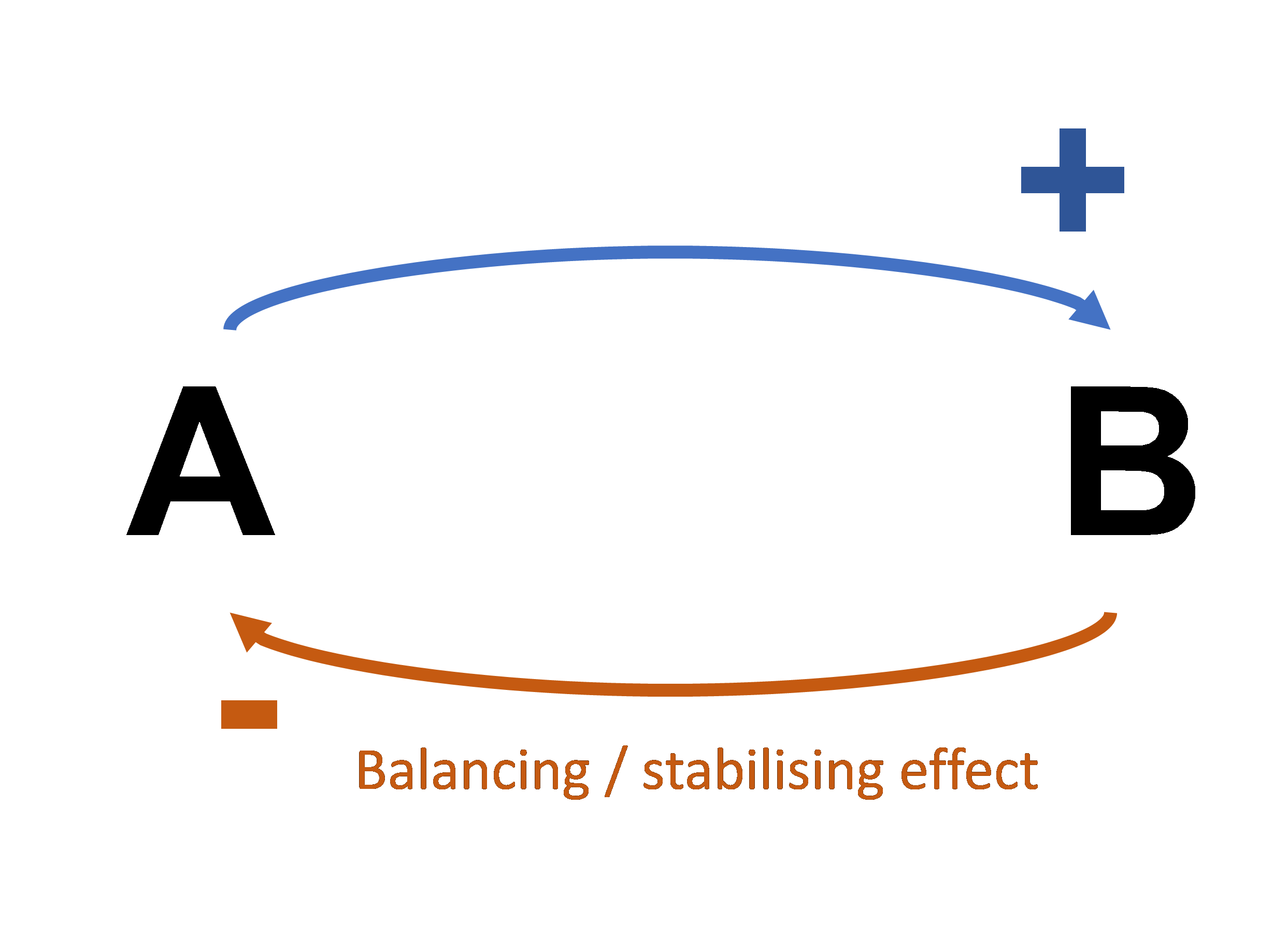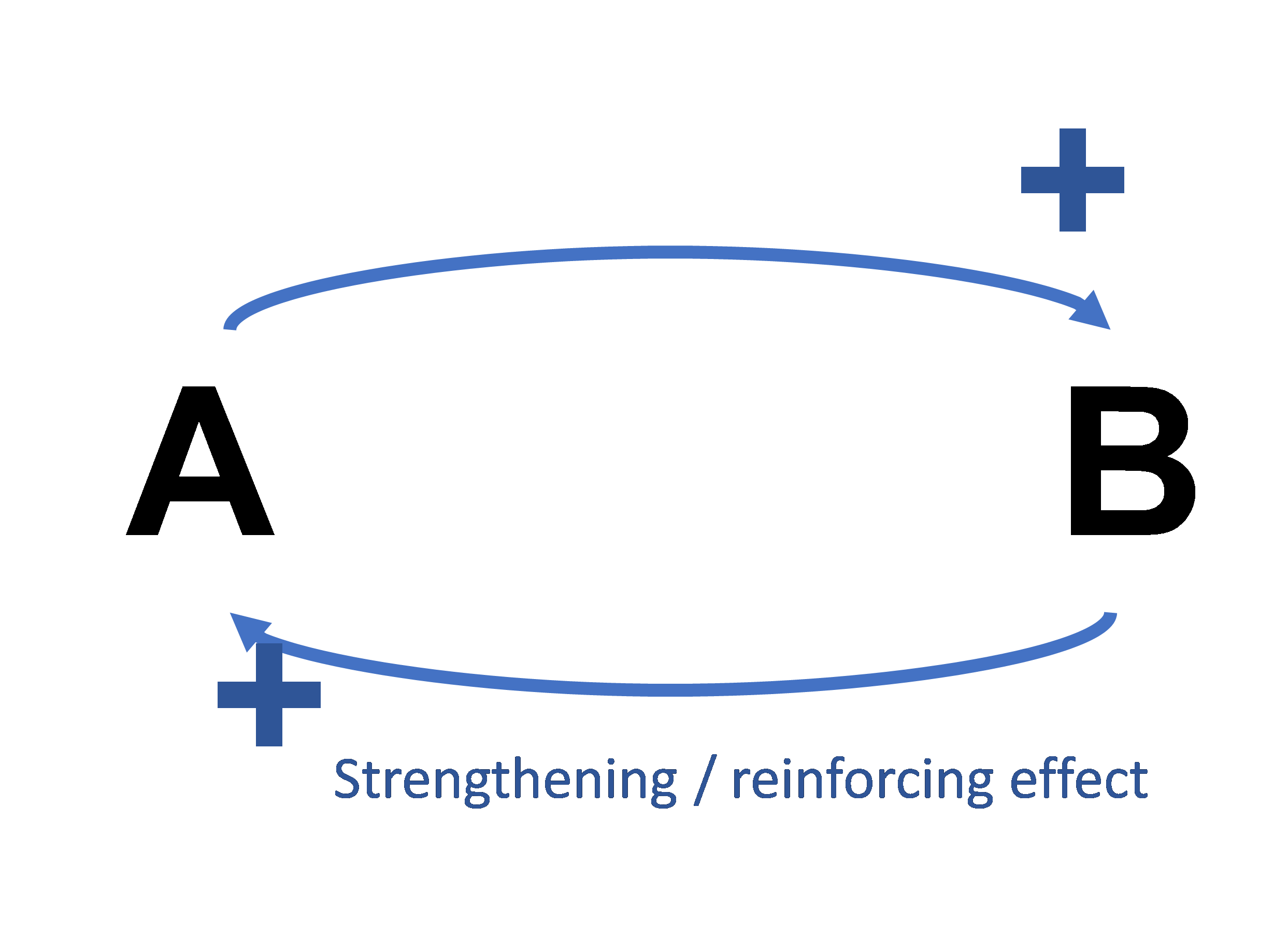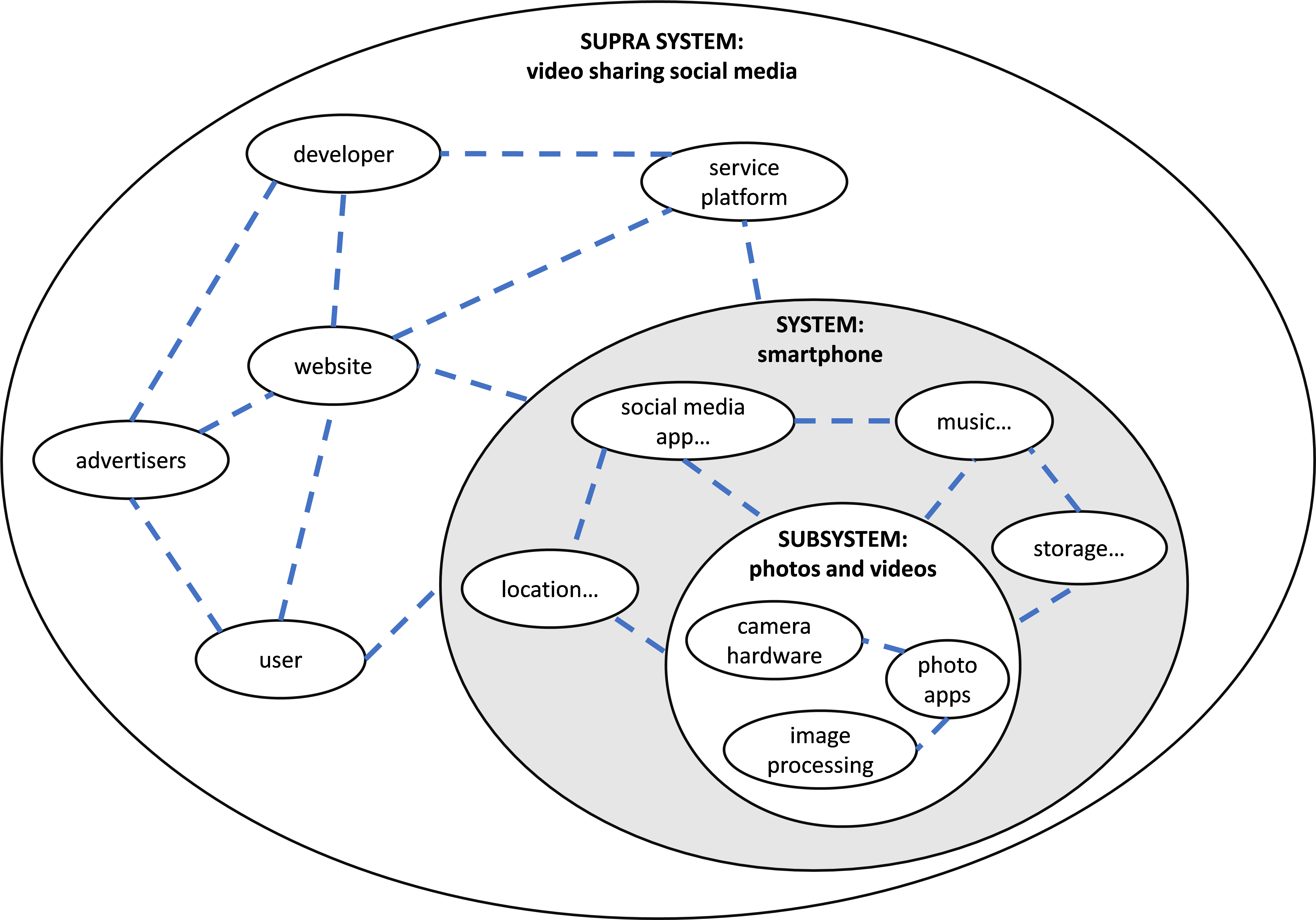Habits of a Systems Thinker

About this lesson
This lesson introduces some of the skills and concepts involved with Systems Thinking. Students are introduced to a number of Habits of a System Thinker, positive and negative feedback loops and the concept of supra- and subsystems.
Year band: 7-8, 9-10
Curriculum Links AssessmentCurriculum Links
Links with the Digital Technologies Curriculum Area.
| Strand | Year | Content Description |
|---|---|---|
| Processes and Production Skills | 7-8 |
Evaluate existing and student solutions against the design criteria, user stories and possible future impact (AC9TDI8P10) Design the user experience of a digital system (AC9TDI8P07) Generate, modify, communicate and evaluate alternative designs (AC9TDI8P08) |
| 9-10 |
Evaluate existing and student solutions against the design criteria, user stories, possible future impact and opportunities for enterprise (AC9TDI10P10) Design and prototype the user experience of a digital system (AC9TDI10P07) Generate, modify, communicate and critically evaluate alternative designs (AC9TDI10P08) |
Links with General Capabilities:
| Capability | Element / Sub element | Content Description |
|---|---|---|
| Digital Literacy | Practising digital safety and wellbeing |
|
| Critical and Creative Thinking | Generating |
|
| Ethical Understanding | Responding to ethical issues |
|
Assessment
This lesson includes a worksheet (see Learning Input) and a final task (see Impact of Digital Technologies).
These items can be used for formative assessment purposes towards the relevant achievement standards below.
Additionally, a self-assessment sheet for reflection is available in PDF or Word format. Skills to be circled on the sheet each relate to activities in this lesson idea.
Links with Achievement standards:
| Level | Achievement standard |
|---|---|
|
Years 7 and 8 |
"By the end of Year 8 students explain how people design, innovate and produce products, services and environments for preferred futures. Students create and adapt design ideas, processes and solutions, and justify their decisions against developed design criteria that include sustainability." "They develop and modify creative digital solutions, decompose real-world problems, and evaluate alternative solutions against user stories and design criteria." |
|
Years 9 and 10 |
"By the end of Year 10, students explain how digital systems manage, control and secure access to data; and model cyber security threats and explore a vulnerability." "They develop and modify innovative digital solutions, decompose real-world problems, and critically evaluate alternative solutions against stakeholder elicited user stories." |
Learning hook
Credit: Looks Who’s Blogging
Watch the short video on Biosphere 2.
Biosphere 2 is an example of a system: a collection of parts that are arranged and connected in a specific way. Interactions between the parts within the system, and between systems, influence the stability of the system as a whole.
It's possible to have a collection of items that don’t form a system, such as appliances in a kitchen. As they are not interdependent, the removal of a toaster will not stop the fridge from working. Similarly, the order in which you place items in a backpack does not affect the usability of each item – they are a collection of items but not a system, because there is no interconnectedness.
As a class, be guided by these questions and activities.
- What was an overarching goal of the Biosphere 2 experiment?
- Try to list as many parts or components of the system (when the experiment took place) as you can. Consider plants, animals, gases, liquids, energy and soil.
- Lower than ideal oxygen levels were a recurring problem during the experiment, and they affected the animals – including the humans. Speculate: What do you think might have caused this?
One suggested cause is the adding of rich farming soil to help boost initial food production when the experiment began. The soil consumed or absorbed more oxygen than the rest of the internal ecosystem could balance out, so oxygen had to be pumped in.
This example shows how causes of problems within a system are often not immediately apparent, and may sometimes only be revealed with observation over time. The designers of Biosphere 2 correctly predicted that many of the added plants and animals would not survive the early stages of the experiment, but may not have foreseen this disruptor.
Learning map and outcomes
Adapt this learning map to suit your student’s needs. For example for students at Year 6, a learning map might look like:
- identify and define a system
- identify and define habits of a Systems Thinker
- find appropriate examples for the application of Systems Thinking habits
- explore the concept of positive and negative feedback loops
- identify subsystems and suprasystems
- apply Systems Thinking habits to an example of digital technologies impact
Learning input
A systems thinker aims to understand the relationships within a system, and the impacts on other systems. By using a wide perspective and tracing interrelationships, systems thinkers can ‘join the dots’ to draw conclusions or make predictions. This is because they note events and patterns of behaviour and understand how these are caused by system structures such as feedback loops. They view things in circles rather than in straight lines. Systems thinkers use tools to help with their thinking such as causal loop diagrams and models.
- With students in pairs, allocate one of the Habits of a Systems Thinker cards from the Waters Center for Systems Thinking to each pair. Download the cards as a PDF.
- Ask students to view the text and image carefully.
- Allocate each pair 10 minutes to prepare a one-minute explanation of how this example illustrates a habit of a systems thinker for the rest of the class. Students use this Habit worksheet to record their ideas in preparation for their explanation.
- Have a general discussion how these habits might relate to the Biosphere 2 experiment.
Learning construction
Negative feedback loops
Feedback loops are an important element in systems thinking. There are two types of feedback loops that help explain how changes have happened within a system and why. Loops imply that feedback works in circles rather than in straight lines.
When a change is happening in a system, a negative feedback loop tends to dampen or buffer the change, leading to more stability. Despite the name, this is often a ‘good’ thing!
The causal loop diagram at right is showing that A causes B, but B has a balancing or stabilising effect on A.

The table below includes three examples of negative feedback loops. As a class, develop some other examples.
| System | Change | Negative feedback | Effect |
|---|---|---|---|
| Human body | Exercise heats up the body | Sweat glands activate | Body more likely to cool |
| Oven with thermostat | Thermometer detects temperature is too high | Heating element is lowered or deactivated | Temperature reduces |
| Online shop | Increasing number of shoppers entering invalid addresses | Data validation added to confirm streets with existing database | Reduced number of invalid addresses |
Positive feedback loops
When a change is happening in a system, a positive feedback loop amplifies or exacerbates the change. This means that change will continue in the same direction, reinforcing its effect. Despite the name, this is often a ‘bad’ thing, because it has the potential to make the system less stable over time. If positive feedback loops continue, a system may undergo ‘boom and bust’ cycles, unravel to a lower level of complexity, or collapse completely.

The table below includes two examples. As a class, develop some other examples.
| System | Change | Positive feedback | Effect |
|---|---|---|---|
| Earth's atmosphere* | More temperature extremes due to climate change | Melting of permafrost releases methane | More methane in the atmosphere accelerates climate change |
| Supermarket and shoppers | Warning about impending stock delivery shortages due to unpredicted event | Panic buying | Stock items sell faster |
* Teachers may highlight here that many systems like the atmosphere are very complicated and not fully understood. Both positive and negative feedback loops exist in our biosphere, and this is just one feedback loop that has been identified.
Subsystems and supra systems
It is often possible to identify subsystems, smaller systems operating within a larger one. For example, in the context of a video-sharing social media platform, an individual smartphone can be seen as a system with interconnected functions – taking photos and videos, using the app, playing music. But even the photo and video functionality is itself a subsystem with interdependent hardware (the camera) and software components (apps and image processing algorithms).
The smartphone is also part of a supra system, relying on the internet for many of its functions, interacting with users, commercial entities, developers and more.

A simplified diagram showing photo and video functionality as a subsystem of a smartphone system in the context of a social media platform for video sharing. The system is itself part of a supra system showing components of the social media platform. (Note, the smartphone is part of many other supra systems.)
Consider other systems now – this time systems of the human body. As a class, complete these statements with subsystem or supra system.
- The nucleus is a ______________ of a cell.
- The liver is a ______________ of cell systems working together.
- Relative to the liver, the digestive system is a ______________ .
- The digestive system is a ______________ of the human body.
Users as part of digital systems
When describing digital systems or information systems, systems thinkers acknowledge that hardware, software and data are not the only components of the system. Users must also interact with parts of a system, usually by following procedures and using interfaces.
Understanding the interactions of a user within a digital system is critical to the development of effective user experience.
Impact of digital innovations
Technology can have far-reaching impacts on cultures, economies and the environment. Think of the impact of older information technologies, like the alphabet or the printing press! Newer information technologies enabled by digital computing are also having impacts on many different systems.
As a class, revise the habits of a systems thinker (see the ‘Learning input’ section) by listing them:
| Seeks to understand the big picture | Observes how elements within systems change over time, generating patterns and trends |
| Considers an issue fully and resist the urge to come to a quick conclusion | Uses understanding of a system structure to identify possible leverage actions |
| Checks results and changes actions if needed: 'successive approximation' | Surfaces and tests assumptions |
| Changes perspectives to increase understanding | Identifies the circular nature of complex cause and effect relationships |
| Recognises the impact of time delays when exploring cause and effect relationships | Considers how mental models affect current reality and the future |
| Recognises that a system's structure generates its behaviour | Considers short-term and long-term consequences of actions |
| Pays attention to accumulations and their rates of change | Makes meaningful connections within and between systems |
Ask students to do the following, using the habits of a systems thinker:
- Choose one of the rows in the table below or come up with your own approved topic.
- Identify one or more supra systems or connected systems affected by the changes the chosen innovation has made to the chosen system (e.g. passengers and drivers using peer-to-peer ride sharing are part of a transport supra system, including private cars, public transport and taxi services).
- Write a list of known impacts from the chosen innovation on the chosen system and on the supra system/connected systems. Consider both of these things:
- two different perspectives within the system
- two different perspectives from the supra system / connected systems.
- Write a list of any future, potential impacts you foresee as the technology continues to be used and/or developed.
| Innovation | System |
|---|---|
| peer-to-peer ride sharing (eg. Uber) | passengers and drivers |
| content recommender systems (eg. YouTube or news feeds) | users and content providers |
| face recognition AI | passengers and airport security |
| home streaming services (eg. Netflix) | home video viewers and content providers |
| app-based food delivery (eg. Uber Eats) | restaurants, deliverers and customers |
| social media (all or choose a specific type) | users and content creators |
| spell-check and autocorrect | students and teachers |
| ‘swipe’ dating apps** | single people and app providers |
** Teacher should exercise caution and awareness of student sensitivities before presenting this as an option. However, this may be a useful tie-in to health topics.
Chosen innovation: app-based food delivery
Chosen system: restaurants, deliverers and customers
Supra systems: dining industry, commercial property, parking and road use
Known impacts:
- Restaurants must adjust or absorb prices to participate in new technology. This may also impact on traditional eat-in or takeaway customers.
- ‘Dark kitchens’ or ‘virtual restaurants’ appear to compete with traditional restaurants. Lower property costs and fewer overheads (e.g. staff to serve customers directly or seat them).
- Customers may not favour local restaurants or recognise localised presence.
- Customers may eat out less frequently. They now have access to delivery of meals that were previously only available via eat-in or takeaway.
- Deliverers take up car parking spaces near restaurants while waiting for food to pick up.
- As part of the Gig Economy, deliverers may not receive the employment security or benefits of traditional restaurant employees.
Possible future impacts:
- Fewer restaurants open to the public. Leads to less-active streets and local communities, particularly at night. This could increase local crime. Customers less inclined to go out at night = positive feedback loop!
- Commercial property affected by fewer active restaurants.
- Local character less critical to restaurant success, leading to homogenisation of offerings and possibly more chains and franchises.
- Deliverers more motivated to reduce transport costs than traditional customers, driving an increase in scooters and bikes instead of large cars.
Resources
- Video: Biosphere 2
- Website: The Waters Center for Systems Thinking
- Video: Systems Thinking video for teachers from CSER (University of Adelaide)
- Habits Worksheet: PDF
- Habits self-assessment sheet PDF / Word